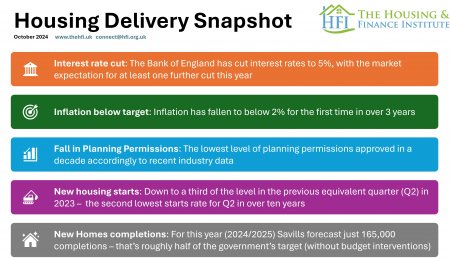

10 MAR 2025
The HFI View: Green shoots but no beanstalk as housing delivery appetite hampered by the lack of support schemes for buyers and the weight of extra taxes
 As with the first signs of Spring, there are emerging shoots of positivity in the housing market. The announcement in the Autumn Budget 2024 of changes to stamp duty coming in from April 2025 has shaken some buyers out of their torpor. Zoopla's latest market report notes "positive momentum" in the sales market. With increase in both sales agreed and homes coming on the market for sale – respective rises of 10% and 11% from a year ago.
As with the first signs of Spring, there are emerging shoots of positivity in the housing market. The announcement in the Autumn Budget 2024 of changes to stamp duty coming in from April 2025 has shaken some buyers out of their torpor. Zoopla's latest market report notes "positive momentum" in the sales market. With increase in both sales agreed and homes coming on the market for sale – respective rises of 10% and 11% from a year ago.
This positive momentum is reflected in UK Finance's housing and mortgage market forecast for 2025 – which is predicting growth for both gross lending and house purchase lending of over 10% in the coming year.
Green Shoots
These modest green shoots are reflected in latest housebuilder predictions for the coming year. In February major housebuilders Barratt Redrow, Bellway and Taylor Wimpey all gave positive forecasts for the number of new homes expected to be delivered in 2025.
Taylor Wimpey described the start of the Spring selling period as "robust" with affordability "moving in the right direction". The housebuilder is expecting own completions of between 10,400 and 10,800 homes to December 2025, up from 9,972 in 2024.
It's a similar picture for the largest housebuilder, Barratt Redrow who reported in February "a strong recovery in customer demand". They are forecasting 16,800 to 17,200 new homes for the financial year to July 2025.
Meanwhile, Bellway are forecasting "at least" 8,500 homes in its year to July 2025 – as against 7,654 homes to July 2024. Bellway also said that "customer demand remained robust".
A thousand extra homes here, 400 or 800 more homes there and a modest uptick in mortgage capacity, makes for more positive mood music for 2025. However, it's a far cry from the scale and pace needed to lift the current building levels towards 300,000 a year. So what's needed to boost housebuilding into major growth?
Ambition and Planning Reform
There are two policy areas which have undoubtedly boosted housing delivery since July 2024: housing ambition and planning reform. These set a positive direction for a longer period than the term of a Parliament. Planning reform provides a concrete commitment to unlocking land at a scale and pace that has not been seen for some time. The prize for supporting housebuilding is not just in the much-needed homes that the country needs. Every additional 100,000 homes adds upwards of £15billion to GDP. It is a major growth contributor to the British economy. Currently, between 1million and up to 1.2million homes could be delivered this Parliament, before additional actions. The current expected gap between the ambition to deliver homes this Parliament and likely output is therefore between 300,000 and 500,000 homes. The prize for closing that gap to deliver an extra 500,000 homes is substantial - up to £75billion of additional value to GDP.
Headwind Challenges
However, turning available land, even with permissions to build, into new homes depends on confidence in the housing market – that means the national economic and financial drivers that support housebuilding.
Builders can build, but buyers need to buy
Builders need buyers. The absence of a replacement for the Help to Buy mortgage support interventions makes it harder for buyers. This is an area that needs urgent attention. Broader economic confidence remains uncertain, both for consumer and business confidence. That means a 'steady as it goes' course is currently set rather than a huge expansion of housebuilding activity. That is especially likely in the next 12 months or so unless the domestic and global economic climate becomes clearer. Economic volatility affects sales demand and investor appetite as well as the costs of materials and labour. To change this it will be necessary to back the buyers with new mortgage support products. Backing the buyers will boost housebuilding and the economy too.
Taxes are holding back delivery
Financially, builders have been hard hit by a range of additional taxes, costs and levies, some of which are legacy taxes and costs, and some of which are new. Legacy taxes and costs include £6billion which the industry has identified for building safety and remediation. On top of this, the Government is imposing a £3.4billion building safety levy. To put those sort of figures in context, that's over £9billion of additional costs. The baseline Affordable Housing programme budget from 2021-2026 was £11.5billion. The building safety cost is therefore getting on to be equivalent in size to the Affordable Housing programme for an entire parliament.
Then there are general business taxes, which affect housebuilding as much as other industries. The National Insurance changes announced in the Autumn Budget 2024 are a significant extra cost for housebuilders. They have been estimated by Arcadis to add up to 1% to construction costs. From extra levies to extra taxes, these are substantial additional burdens on new housebuilding.
Special spiders and newts have the upper hand
While there are proposals to tackle environmental blocks and barriers in the upcoming Planning and Infrastructure bill, there are concerns that this could result in another set of taxes for builders. Smaller builders are particularly hard hit by the current planning, environmental and infrastructure environment. A more balanced approach to managing newts, bats, biodiversity net gain – and the latest development scourge, jumping spiders (which have just seen off 1300 homes at Ebbsfleet in Kent) - would be welcome.
Government after government has been seen off in attempts to balance the competing and sometimes conflicting interests between the natural and built environment. If the latest proposed legislation places further financial burdens on building to pay even more for other industries and special interests, that could even be a further drag on building. If, on the other hand, the government does achieve a practical and cost-effective new approach, it will be a real victory and reap huge dividends in both protecting nature and boosting housebuilding.
Delivering more affordable housing as temporary accommodation and rough sleeping figures show the scale of the crisis
As numbers of new homes fall far below target, the temporary accommodation and rough sleeping numbers have continued to soar. Latest temporary accommodation figures are shocking - more than 126,000 households in temporary accommodation, with more than 164,000 children in temporary accommodation. Rough sleeping is at the highest level for several years.
In 2023, the Housing & Finance Institute established a taskforce, Operation Homemaker, to deliver new affordable homes at pace to tackle the temporary accommodation crisis. Many housing associations are struggling to take on new affordable homes due to their own financial and management challenges in sorting out homes in disrepair. In turn, this is holding up housebuilding where sites can't progress without affordable housing being delivered. New approaches, like Homemaker, bring together a coalition of the willing to tackle homelessness. It was welcome that the Government's response in February 2025 to the previous Housing Select Committee report into social housing finance has positively recognised the role of a range of housing providers and institutional investment, including 'for profit' providers alongside traditional housing associations. Working with institutional investors and a range of housebuilders and housing providers, the ambition to reverse the current homelessness crisis can be met.
In Conclusion
This Spring there are green shoots, but there's an urgent need for more action to spur growth in housebuilding.
Backing the buyers with new mortgage and home deposit support products would make a huge difference. Particularly for younger buyers and households on lower incomes.
Temporary accommodation homelessness is at record levels – against a backdrop of housing associations pulling back from the market and sites stalled. Working differently to bring forward new build social and affordable housing is a must.
A way through the environmental and broader regulatory quagmire must be found in order to turn incremental housebuilding growth into a step change for housing delivery. The upcoming Planning & Infrastructure bill is an opportunity for real change.
Undoubtedly the ambition from the Government is there to build more homes. There's a lot at stake in the Spending Review and upcoming legislation to provide the stimulus and rocket boosters to accelerate both housing delivery and wider national economic growth.
March 2025 Housing Delivery Snapshot

January 2025 Housing Delivery Snapshot

December 2024


